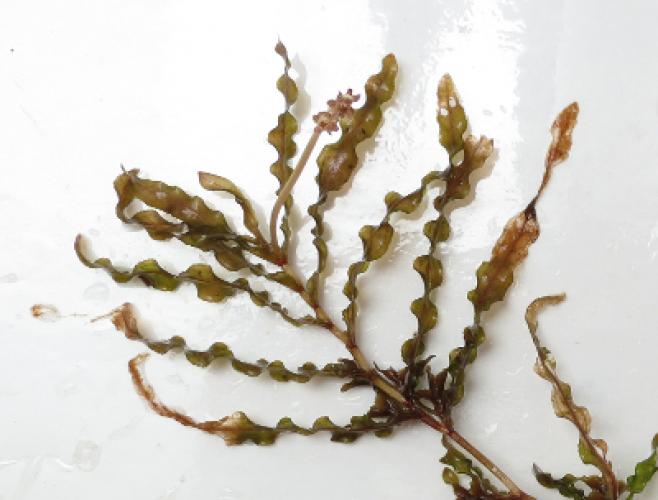Curly-leaf Pondweed
Identification
Curly-leaf pondweed is a submersed aquatic plant with alternate leaves, toothed along their margins. Leaves are an olive-green to reddish-brown color, narrow, attached directly to the stem, and are wavy (much like a lagagna noodle). There is a conspicuous mid-vein on each leaf. Small, greenish-brown/red flowers appear above the waterline during the plants flowering season. Curly-leaf pondweed can grow up to 5 meters in length. Plants will appear with flattened leaves, blue-green in color, during the winter.
Biology
Origin
Eurasia, Africa, and Australia
Habitat
Curly-leaf pondweed is typically found in lakes and ponds, but can be found in irrigation canals and drainage ditches. It can thrive in polluted and eutrophic waters, and is tolerant of a wide range of water chemistry conditions. This species typically grows in areas with a silt or clay substrate, but has been found growing in areas of gravel or sand. The plant can grow in low-light conditions such as those caused by turbid waters, and can be found in water up to about 7 meters in depth.
Ecological Threat
Curly-leaf pondweed can grow in dense stands, restricting the growth of native plants, depleting nutrients (a potential problem for the productivity of fisheries), and impacting water-based recreation.
Life cycle
Curly-leaf pondweed plants will survive the winter intact, even under thick ice. Plants flower, produce fruit, and create turions (the plants reproductive mechanism, capable of overwintering in a dormant state) in early June. Growth rates of 8-10 cm/day have been observed during the spring, when water temperatures exceed 10 degrees Celsius.
Vermont Distribution
P. crispus is found within the Black-Ottauquechee, Lake Champlain, Mettawee River, and Winooski River drainages in Vermont. This species has the potential to expand its range in Vermont via transport on waterfowl, intentional planting, and unintentional transport.
How You Can Help
For most aquatic invasive species, humans are the primary vector of transport from one waterbody to another. Many of these nuisance plants and animals can be unknowingly carried on fishing gear, boating equipment, or in very small amounts of water in a watercraft. The easiest and most effective means to ensure that you are not moving aquatic invasives is to make sure that your vessel, as well as all your gear, is drained, clean, and dry.
BEFORE MOVING BOATS BETWEEN WATERBODIES:
-
CLEAN off any mud, plants, and animals from boat, trailer, motor and other equipment. Discard removed material in a trash receptacle or on high, dry ground where there is no danger of them washing into any water body.
-
DRAIN all water from boat, boat engine, and other equipment away from the water.
-
DRY anything that comes into contact with the water. Drying boat, trailer, and equipment in the sun for at least five days is recommended. If this is not possible, then rinse your boat, trailer parts, and other equipment with hot, high-pressure water.
Interested in monitoring for aquatic invasives?
- Join the VIPs! Vermont Invasive Patrollers help search for new infestations so we can respond immediately and prevent them from becoming established.
Citations
Catling, P.M. and I. Dobson. 1985. The biology of Canadian weeds: 69. Potamogeton crispus L. Canadian Journal of Plant Science 65(3):655-668.
Holm, L., J. Doll, E. Holm, J. Pancho, and J. Herberger. 1997. World weeds: natural histories and distributions. John Wiley and Sons, Inc, New York, NY.
Thayer, D.D., I.A. Pfingsten, L. Cao, and L. Berent., 2017, Potamogeton crispus L.: U.S. Geological Survey, Nonindigenous Aquatic Species Database, Gainesville, FL, https://nas.er.usgs.gov/queries/factsheet.aspx?SpeciesID=1134, Revision Date: 3/18/2016, Access Date: 8/1/2017
Tobiessen, P., and P.D. Snow. 1984. Temperature and light effects on the growth of Potamogeton crispus in Collins Lake, New York State. Canadian Journal of Botany 62:2822-2826.
